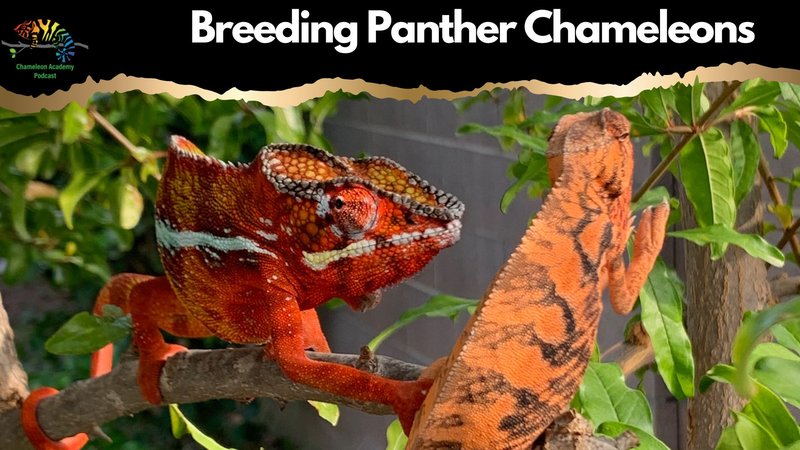
It’s not just about having a couple of chameleons; it’s about understanding their behavior, habitat, and nutritional needs. Let’s dive into everything you’ll need to know about breeding these incredible reptiles. Whether you’re just starting out or have had a few chameleons before, this guide will help you tackle everything from creating the perfect environment to understanding the challenges that come along the way.
Understanding Panther Chameleons
Before you even think about breeding, it’s essential to know what makes *Panther Chameleons* unique. These reptiles are known for their dynamic color changes, which can reflect their mood, health, and even social status. They’re native to Madagascar, thriving in lush, tropical environments. This is something you’d want to mimic in your breeding setup.
You might be wondering, “What’s the big deal about their colors?” Well, those vibrant hues serve not only as a form of communication but also as a defense mechanism. A stressed chameleon will often show darker hues, while a happy one might bask in an array of bright colors. Understanding these signals will help you create a supportive environment that encourages breeding.
Chameleons are solitary by nature, which means they don’t usually cuddle up together like some other pets. Instead, they are territorial and can have aggressive tendencies, especially the males. This behavioral trait is crucial for you to consider when pairing them for breeding, as not all males and females will get along.
Setting Up The Perfect Habitat
Creating the right environment is like setting the stage for a play: everything must be just right for the stars to shine! The habitat should mimic the chameleons’ natural surroundings, which includes a mix of humidity, temperature, and plant life.
– Size: A minimum of a 30-gallon enclosure is recommended for one adult chameleon, but larger is always better. Think about it like giving them space to roam and hide.
– Humidity: *Panther Chameleons* require humidity levels between 50-70%. You can achieve this with live plants, a good misting system, or even a simple water dish.
– Temperature: During the day, the basking spot should reach 85-90°F, while the cooler areas should be around 75-80°F. This temperature gradient allows your chameleons to thermoregulate, which is crucial for their health.
Adding plenty of branches, vines, and foliage inside the enclosure not only creates hiding spots but also encourages natural behaviors. You can use non-toxic plants like pothos or hibiscus for aesthetics and functionality.
Choosing the Right Pair
Once your habitat is set up, it’s time to think about pairing your chameleons. Selecting the right male and female is a bit like matchmaking for your pets. Not every chameleon is going to get along, and understanding their personalities is key.
You’ll want to choose a healthy male and female. Look for vibrant colors in the male, as this indicates good health and readiness to mate. The female should be active and show no signs of stress or illness. Once you have your pair, it’s important to introduce them gradually.
Start by placing them in adjacent enclosures, allowing them to see and smell each other for a few days. If they seem relaxed, you can try introducing them in a neutral space. Keep a close eye on their interaction, as a fighting pair can lead to injury.
Breeding Process Step-by-Step
Now comes the exciting part: the breeding process! The breeding season typically occurs in the spring, and the male will often display courtship behaviors—think vibrant colors and head-bobbing.
Here’s a simple breakdown of the steps involved:
1. Introduce Your Pair: After a few days of observation, introduce your pair in a spacious area of the enclosure.
2. Observe Mating Behavior: If they seem to tolerate each other, you may notice the male courting the female.
3. Egg-laying: After successful mating, the female will need a special laying site. Provide her with a laying bin filled with moist sand or soil about 10 inches deep.
4. Incubation: Once she lays her eggs, you should remove them and place them in a separate incubation container with the right moisture and temperature.
Each clutch can contain anywhere from 10 to 30 eggs! It might take about 6 to 9 months for the eggs to hatch, so patience is crucial!
Nutritional Needs During Breeding
Nutrition plays a huge role in the health of both your chameleons and their eggs. A healthy breeding diet will consist primarily of live insects. Think crickets, roaches, and worms. Here’s how you can ensure they’re getting what they need:
– Variety is Key: Offer a mix of insects to provide a well-rounded diet. Don’t just stick to crickets; include mealworms and dubia roaches for variety.
– Gut Loading: This means feeding your insects a nutritious diet before feeding them to your chameleons. It’s like making sure your food is packed with all the right vitamins.
– Supplements: Dust their food with calcium and vitamin D3 supplements at least two to three times a week, especially for females before and after egg-laying.
Here’s the thing: a well-fed chameleon is a happy chameleon!
Challenges of Breeding Panther Chameleons
As rewarding as breeding can be, there are certainly challenges to keep in mind. One of the biggest issues is handling stress. *Panther Chameleons* can easily become stressed from environmental changes, improper lighting, or even handling.
Another challenge is ensuring that the female is healthy, especially after laying eggs. Egg-binding can occur if she doesn’t have a suitable place to lay or if she isn’t healthy enough to do so. This condition can be dangerous and sometimes even fatal.
You might also face issues with fertility. Not every mating session results in successful eggs. If your female doesn’t seem interested, it could be due to stress, inadequate conditions, or health problems. Keeping her environment as stress-free as possible is key.
Support and Resources for Breeders
If you’re feeling overwhelmed, don’t worry! There are plenty of resources available to help you along the way. Online communities, forums, and social media groups dedicated to chameleon enthusiasts can be invaluable.
You can also find books and articles written by experienced breeders, offering tips and sharing their own stories. Keeping updated with the latest research on *Panther Chameleons* will help you stay ahead of any challenges you might face.
Support from fellow breeders can help ease your worries and provide you with practical solutions based on real-life experiences.
Breeding *Panther Chameleons* is a fascinating adventure filled with opportunities for learning and growth. While it comes with its share of challenges—from creating the perfect habitat to ensuring a successful pairing—each step is incredibly rewarding. By understanding their needs, respecting their natural behaviors, and being patient, you’re setting yourself and your chameleons up for success.
So, if you’re ready to embark on this colorful journey, take a deep breath and dive in! With the right knowledge and care, you’ll not only enjoy this unique breeding experience but also contribute to the thriving world of *Panther Chameleons*. Happy breeding!

